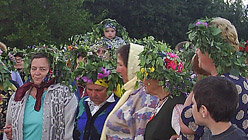When the economy takes a turn for the worse, arts institutions and programs often suffer from cutbacks because of the perception that the arts are a dispensable luxury. But even as the Obama administration puts together an economic stimulus package that includes $50 million for the National Endowment for the Arts (NEA), economists such as Amity Schlaes debate what the federal government’s role should be in sustaining a vibrant arts community in America.
Spark, in a joint report with The NewsHour, looks at the impact of the economic recession on artists such as muralist Sirron Norris and writer Carla Blank and discusses whether a public arts program similar to the Federal Art Project (FAP) of the 1930s is a viable way to help artists who are feeling the financial pinch.
During the Great Depression, amidst programs that would eventually employ some 3.3 million people, Franklin Delano Roosevelt’s Works Progress Administration actively sought to bring relief to working artists by sponsoring a wide range of public-art projects as part of the New Deal. These projects helped, among others, Jackson Pollock, Mark Rothko, Philip Evergood and Lee Krasner.
Under director Holger Cahill, the FAP — following in the footsteps of Roosevelt’s earlier Public Works of Art Project, whose purpose was “to give work to artists by arranging to have competent representatives of the profession embellish public buildings” — created more than 5,000 jobs for artists and left a legacy of 225,000 works of art for the American public in the eight years of its existence. With offices in 48 states, the FAP commissioned works of art for numerous public buildings, managed community centers and arts programs, and sponsored exhibitions across the country. By the time the program came to a close with the advent of World War II, the thousands of artworks produced under its auspices, many of them still enjoyed today, had not only decorated American institutions and given struggling artists temporary employment, but also helped document American life.
But even beyond the aesthetic gratification that art provides is the idea that the arts can actually help drive economic prosperity — that bolstering the creative sector significantly helps the larger economy. A 2008 study, Artists in the Workforce, released by the NEA estimates that there are 2 million artists working in the United States, equivalent to 1.4 percent of the American workforce. Even more non-artists are employed by arts organizations in administrative and production roles. The research organization Americans for the Arts notes that “nonprofit arts organizations and their audiences generate $166.2 billion in economic activity every year, support 5.7 million jobs and return nearly $30 billion in government revenue every year. Every $1 billion in spending by nonprofit arts and culture organizations and their audiences results in almost 70,000 full-time jobs.”
As Carla Blank states in a 2009 op-ed in the San Francisco Chronicle, “The 21st-century version of New Deal arts programs could feature creative partnerships between artists and scientists, engineers, businesses, educators, skilled labor, city planners and community leaders throughout our nation’s cities and rural communities. When such collaborations are successful, they are called a renaissance.”
Resources
- Array
- Array
- Array
- Array
Related Episodes
Kitka, May, Arts and the Economy
Learn more about Eastern European musical traditions, unique sewing techniques, and the climate of arts in the current economy.

